|
My dad was a J.R.R Tolkien nut, so, of course, when the CCG boom happened, we latched on to Middle Earth: The Wizards, a CCG about having adventures in middle earth. This is, of course, different from the later Decipher LoTR game, which came out after the movies. Fundamentally, you have two "halves" to your deck, 30 "free peoples" cards that help you to win, which you use during your turn, and 30 "shadow" cards to stop your opponent from winning, which you use on other player's turns. A Free People's card-  A Shadow Card -  The goal of the game was to gather 20 marshalling points (henceforth, MP) before your opponent, and then call a "free council" to do final scoring, which had its own set of modifier. At the start of the game, you set out 20 mind points of character (Aragorn, above, has 9 mind, and is insanely overpriced, stats-wise, mostly because there's a large number of specific cards that require him to be in play to work) and began in Rivendell. A sample starting party might look like this-     On your turn, your parties (you can have more than 1 group of yahoos running around, though our play tending to lean towards having a single giant mass of folks) travel to a site (see Weathertop, a lovely site below)-  , ,generally by looking at a map of Middle Earth and picking your route, noting the symbols that you pass through - 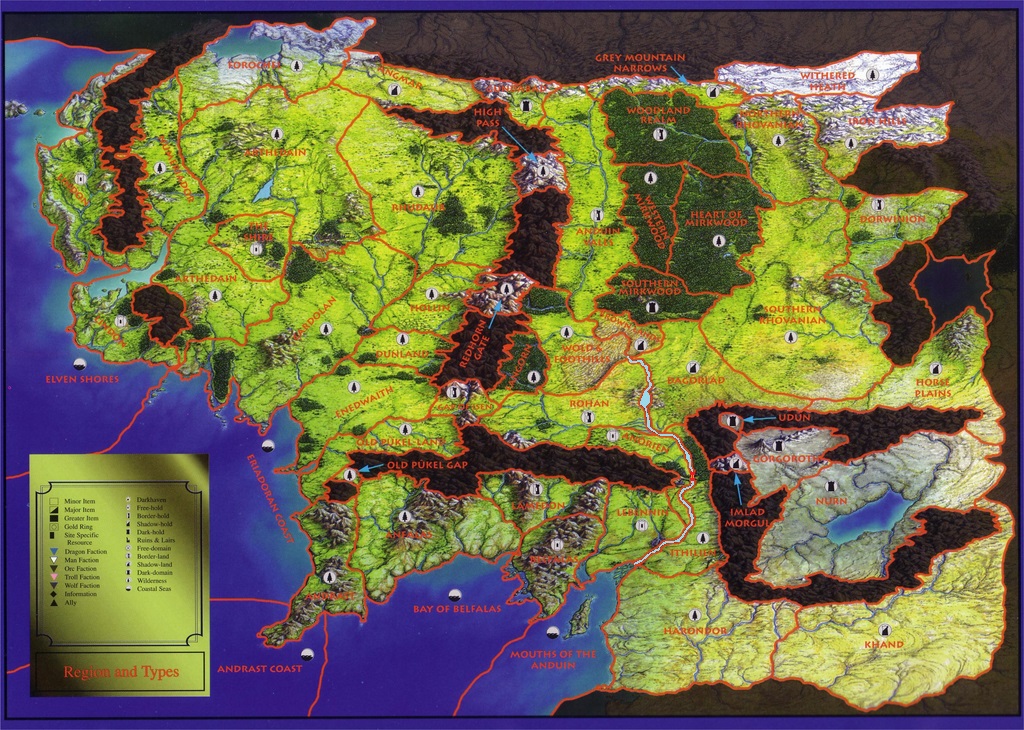 Of course, if you start at one of the havens, the site cards helpfully list a path there. When you move, your and your opponents draw cards as listed on the card (Weathertop above, gives both players 1 draw, again, not a very interesting location). Your opponent(s) then have a chance to play hazards against you, to a maximum of 1 per character in the moving party. Hazards generally take the form of attacking monsters or events, and, to be played, require either a match on the site you’re traveling to or the site path. These orcs, for example, can be played either to the wilderness in the path to Weathertop or at the ruins themselves-  When attacked by a creature, you have to deal with each of the “strikes” of the creature. For these guys, that’s 6 power in 4 strikes. Normally, a character can defend against 1 strike, tapping to do so, and comparing their prowess (the left number in the shield) +2d6 against the prowess of the strike. However, you might want to handle a second strike (-3 to character prowess) or without tapping (-2 to character prowess) Boromir, for example,  can handle a single strike of the orcs without tapping automatically (6 -2) + 2d6 >= 6, and has a very good chance of handling 2 strikes without tapping (6-5) +2d6 >= 6. Assuming all the strikes of the attack are defeated, you can claim the defeated creature for their points value (the orcs are 1 point) and then do the same thing for each hazard on the path (if someone had choked on a roll, or even tied the orcs instead of beating them, you wouldn’t get the point, and the character would have to make a body check, trying to roll under the right number to avoid dying and instead just being wounded, which required going back to a haven to heal). can handle a single strike of the orcs without tapping automatically (6 -2) + 2d6 >= 6, and has a very good chance of handling 2 strikes without tapping (6-5) +2d6 >= 6. Assuming all the strikes of the attack are defeated, you can claim the defeated creature for their points value (the orcs are 1 point) and then do the same thing for each hazard on the path (if someone had choked on a roll, or even tied the orcs instead of beating them, you wouldn’t get the point, and the character would have to make a body check, trying to roll under the right number to avoid dying and instead just being wounded, which required going back to a haven to heal). Finally, you arrive at the site,  And have to face another round of attacks at the site (2 strikes of 6 power wolves) and get to play….  for 1 big point (assuming Bilbo made it through everything untapped, or else you'd have to wait for next turn) ! Finally, at the end of your turn, each player refills their hand to 8 cards, and play passes to the next player. Needless to say, the game played rather slowly. In particular, some of the more powerful strategies involved moving between low risk locations and influencing factions, like the Men of Lake Town, to support you by rolling and adding the character’s direct influence (the hand value) against the faction’s value.  My personal favorite deck involved bumping around Bag End, recurring the site to allow you to assemble 20 points worth of hobbit allies while exposing you to almost zero danger (I was a very timid child). There were decks about having a bunch of dwarves going to the Lonely Mountain to become King under the Mountain, decks about Aragorn becoming King of Gondor, decks about raiding dragon lairs to grab a bunch of magic weapons, etc. In general, however, to actually play an interesting deck involved getting together a lot of rare cards, because you'd need not only Aragon, for example, but also Minas Tirith (the site), the card to crown him with, and various factions in the area to ensure that you make the magic marker of 20. Of course, if Aragorn dies during the game, you basically lose, because no-one else can replace him. The game also had a whole bunch of special rules, including searching for rings to try to find the One Ring (accomplished by gathering rings, information, and then rolling a bunch of dice and hoping for very lucky results), which you can throw into Mt. Doom to automatically win the game. There are also rules to try to recruit other players’ characters and factions away from them, which I remember as being very annoying and complex. Over the course of the lifecycle of the game, more complexity was added in the form of a bunch of new ways to play were added, including playing as Nazgul (in The Lidless Eye expansion), or a corrupted wizard (in the Fallen Wizards expansion). Fundamentally, the game does a much better job of making you feel like you’re wandering Middle Earth than the later Decipher game, but a much worse job than the current FFG LCG. Nevertheless, I had a lot of fun playing with my Dad, but that didn’t have much to do with the game itself.
|
|
|
|

|
| # ¿ May 18, 2024 10:03 |
|
In the spirit of keeping things going - To boldly go where many goons have gone before, the Decipher Star Trek CCG  What is the Decipher Star Trek CCG? Star Trek is a game primarily about playing solitaire faster than your opponent and pushing your luck. The core game does a good job of emulating episodes of Next Generation or The Original Series, but it very quickly became insanely bloated with weird complexity, edge cases, and silver bullet cards, in addition to having a core balance problem. That's all well and good, but what is a game like? At the start of the game, you establish a “Spaceline” of missions, taking turns with your opponent to seed 6 locations, each of which generally has a mission associated with it, like so:  Missions have requirements (the mission shown above requires a Federation, Bajoran, or Non-aligned team with the listed skills and stats) and a points value, which you get for solving the mission (here 25) and all locations have a “range” (here, 3) which is the cost to move to them from the adjacent location. Then, players take turns seeding the spaceline with cards from their seed deck (normally 30 cards, if I remember correctly). Seeded cards were generally one of Outputs, which limit what characters and ships you can play - Dilemmas, which are hidden under your opponent’s missions to slow them down by stopping or killing their team, like so  Or weirder stuff, like Q’s tent (which allows you a sideboard of weird silver bullet cards)  As the game progressed, the seed phase got more and more complex, but this was the phase that allowed you to interact with the opponent the most, so treasure it. Once turns began, players on the turn could play exactly one card, like a character-  Who has a set of 3 attributes and maybe a couple of skills, designed to overcome the mission requirements and likely Dilemmas your opponent seeded A ship -  Or an event-  There were also interrupts, which didn’t count against the 1-per-turn rule. Then, if you had a ship and sufficient crew to fly it, you could move the ship up the the ship’s range in distance units, and, if you were feeling lucky, attempt a mission. Missions were the primary way to win, with the player getting to 100 points first winning. You can also effectively force a win if you can blow up your opponent's outpost, as they won't be able to play any more cards, but that was a difficult thing to accomplish. When you attempt a mission, you flip over seeded cards, in seeded order, 1 at a time, completely resolving the card before moving on to the next one. An important note is that unless the attempting team is completely killed or the Dilemma specified that it stops the team, they’ll continue to move forward. Therefore, a common strategy was to attempt a mission with a small team of disposable characters in hopes they could trip the really brutal killing Dilemmas without risking your big important characters, which did a great job of emulating the shows. This could be countered by including some “walls” (Dilemmas which forced a team to stop) before the kills, but then there was no cost to seeing what skills you needed before attempting again. The choice of which mission to attempt, and how much to commit to an attempt could be really interesting in a bluffing and reads sense, since you knew how many cards were seeded under each mission, but the fact that space missions required you to commit your entire crew (unlike planet missions, which let you choose how many folks to commit to the attempt) and that knowing who and how much to commit required you to memorize a whole huge number of Dilemmas really went against the core “call or fold” fun. Speaking of red-shirts, one of the core problems of the game (and there were many) was the fact that there were no resources, so a really amazing card like  With a lot of skills and a pretty good stat line cost exactly as much as some random joker like  Now, all card games have a power differential between good and bad cards, but the discrepancy was HUGE and there was basically no point in including “lower value” cards, unless you really needed a specific skill and you couldn’t find it elsewhere. They tried to remedy this by massively inflating the skills and stats of completely random cards in various factions, so it wasn’t just “amazing Enterprise crew vs. Klingon Scrub Squad”, but there generally was no room for common characters or ships in most decks. Another way they tried to get around the 1-per-turn rule was the inclusion of download icons on characters, which let you search your deck and put into play a specific set of card when they came into play, like so- Who downloads a Defense System Upgrade, but you can see that it was generally used more as a flavor than a balancing tool. Another major issue with the game was the lack of player interaction. While you could theoretically try to build a deck to fly your ship over and shoot at your opponents, it generally wasn’t worth it, although you could occasionally slow players down for a couple of turns that way. Stealing the other player’s missions was hard (you’ve probably build your deck to solve your missions, and you might not be even playing a faction that can attempt the mission), and hate cards were even printed to stop this  Hate cards were another big part of the game, with a lot of really crummy “take that” style of play-  As the game went on, things got increasingly complex, with the need to seed separate Delta and Gamma quadrant locations, which weren’t accessible without specific cards, and goofy things like the aforementioned Q’s tent, various locations on Deep Space 9, Alternate Universe doors  and other goofy stuff-  That said, I was fond of some goofy cards, like Devidian Door, which let you play things “from the future” at no cost, with the requirement that you remove a Devidian Door from your hand next turn or lose. 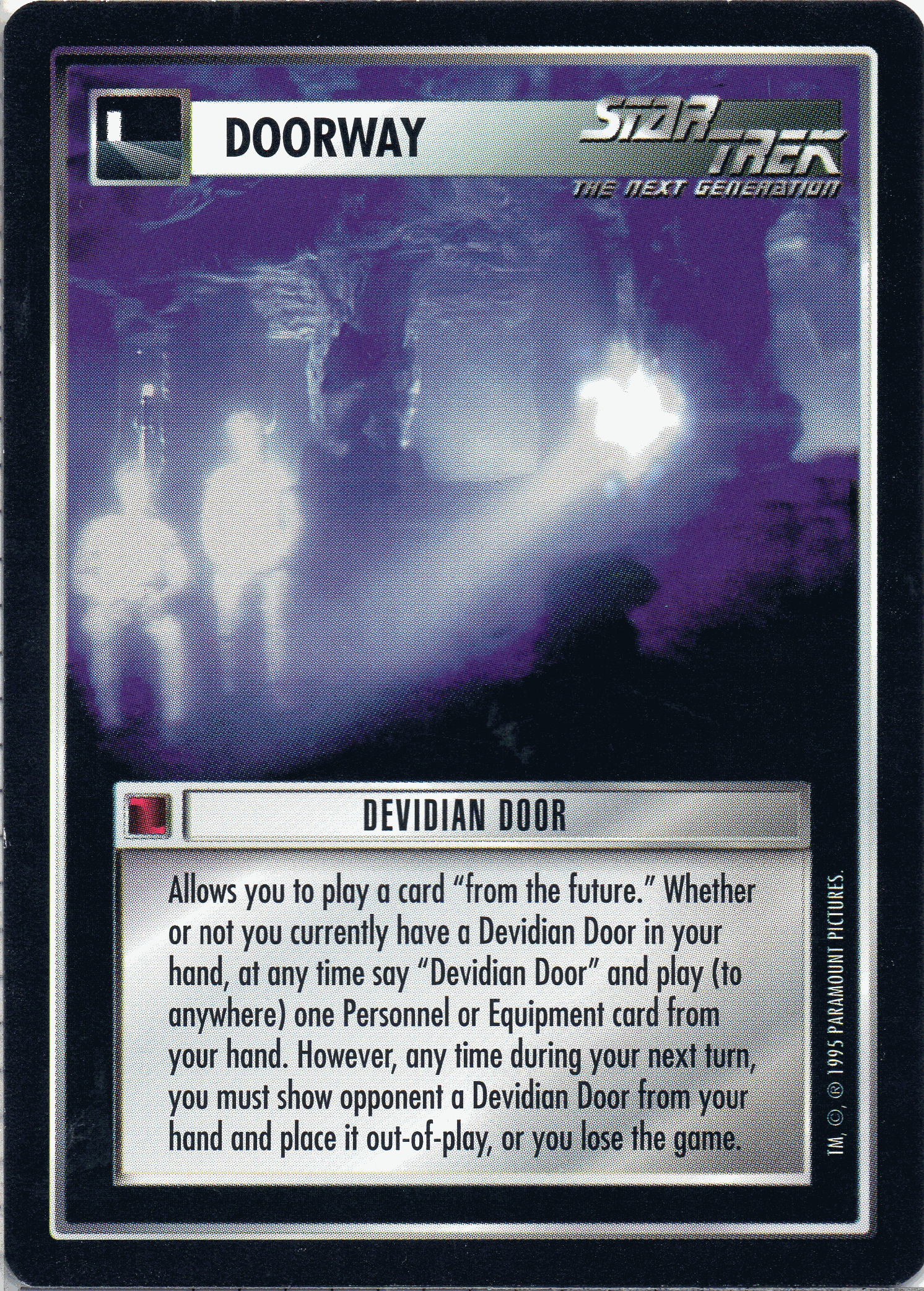 I understand some people are keeping the game going a-la Netrunner’s project formerly known as Nisei, but I cannot in good conscience recommend the game, other than as a curiosity. nomadotto fucked around with this message at 05:25 on Aug 5, 2022 |
|
|
|
Magnetic North posted:
|
|
|
|
Two Fellowships were racing for the good of all mankind: The Decipher LoTR TCG What is Decipher THE LORD OF THE RINGS™ Trading Card Game (DLoTR)? DLoTR is a game where you simulate competing versions of the Peter Jackson LoTR movies. You take turns playing as the fellowship, trying to get to the end of the movie as quickly as possible (they were a little long). That's all well and good, but what is a game like? DLotR is fundamentally a race/push-your-luck game, where players attempt to move their fellowship from site 1 to site 9 as quickly as possible. The push your luck element was really interesting, due to the resource system, but I’m skipping ahead. Players build 2 decks, one consisting of at least 60 cards, equally mixed between Shadow cards (which you use to attack your opponents) and Free Peoples cards (which you use to move yourself forward). The second deck is a set of 9 sites, numbered 1-9. A site 1 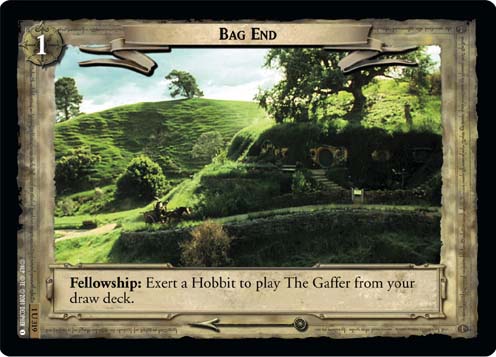 A site 2  At the start of the game, players choose a fellowship. A player’s fellowship consists of A Ringbearer (generally Frodo)  And, of course, The One Ring (of which there were different copies with different rarities- 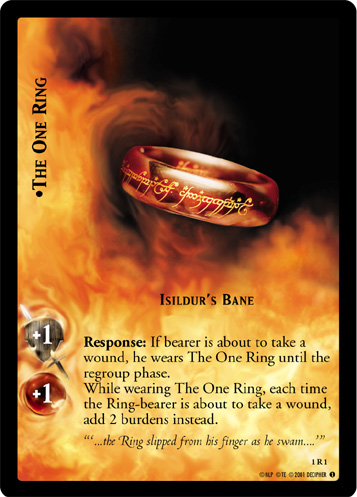 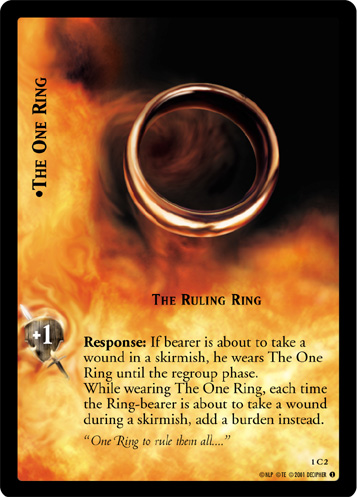 (unsurprisingly, the rare Ring was generally better than the common one) Along with 4 cost worth of companions Companions are generally the main characters from the movies, like Aragorn  Or Gimli- 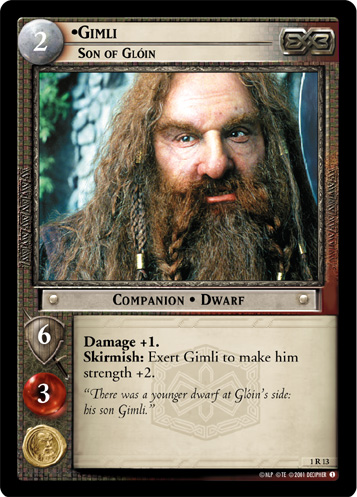 Characters (Companions and Allies, a card type I’ll discuss later) have 4 elements, A Cost, in the top left (Aragorn is 4 and Gimli is 2) A Culture, in the top right (used to trigger game effects) (Aragon is a Man and Gimli is a Dwarf) A Strength (the number in the shield) which represents how well they fight (Aragorn is 8 and Gimli is 6) And a Vitality (the number in the red/orange circle) (Aragorn is 4 and Gimli is 3) And may also have a signet (weird face-y thing in the bottom left) indicating a sort of “affiliation” separate from culture (Gimli and Aragon both have a Gandalf signet). Then, players bid burdens for the right to go first. Burdens represent corruption on the ringbearer, and, if your ringbearer ever has burdens equal to or greater than their resistance, you lose the game. The other way you lose the game is if your ringbearer is killed, so don’t let that happen. Bidding was quite a delicate art, since choosing sites can have a huge impact on your deck's performance, but overbidding can put you in a tough spot from the start. The player going first chooses what Site 1 to begin at. Importantly, once a site is in play, that site is the site for BOTH players (baring site control shenanigans). As an interesting catch-up mechanic, when a player moves to a number NOT YET on the board, their opponent gets to pick the site that they move to. For example, a player moving from Site 5- 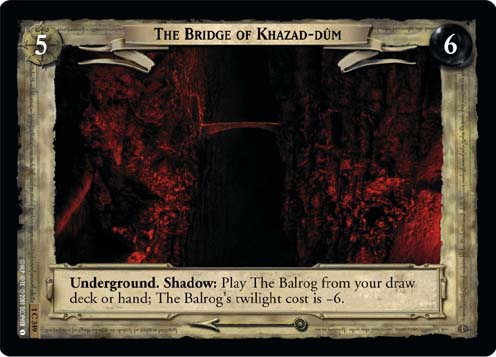 To an unknown Site 6 will have to deal with their opponent’s choice of Site 6, for example, 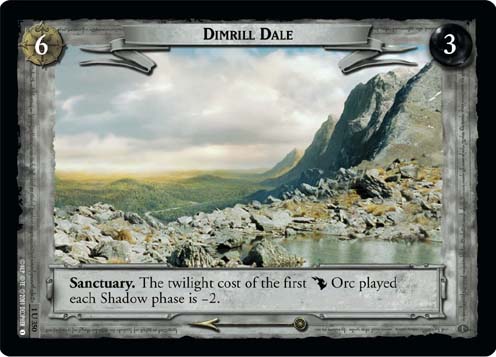 , which is likely to benefit someone playing a Moria Orc shadow deck, which is probably your opponent, and not, for example, someone playing a Nazgul shadow deck. , which is likely to benefit someone playing a Moria Orc shadow deck, which is probably your opponent, and not, for example, someone playing a Nazgul shadow deck. Anyway, back to the proper turn order. The first phase is the Fellowship phase. At the start of the phase, if you’re at a Sanctuary (Sites 3 and 6), you heal 5 wounds from your Companions. This is the only “default” healing that occurs (you can discard duplicate characters to heal during the Fellowship phase to heal a wound at any location, but that’s not super common), and ties into an aspect of the game’s action limits. Unlike other similar games, there’s no “tap” state, instead, cards Exert (take a wound) as a cost to activate actions. During this phase you can also take fellowship actions (actions that say Fellowship: ) and can play any number of fellowship cards. Each card played adds its cost to the Twilight Pool. The more stuff you play, the more “ammunition” you’re giving to the other player to throw back at you, so be careful about how much stuff you’re playing. Fellowship cards are Companions (discussed above), Conditions (similar to enchantments in something like Magic), Possessions (stuff your characters have), and Allies. Allies represent people your fellowship meets during the travel, but who do not adventure with you, like Elrond. They are an interesting hybrid, where they behave like Companions when you are at their home site (Elrond’s is 3), but are effectively Condition-like otherwise. 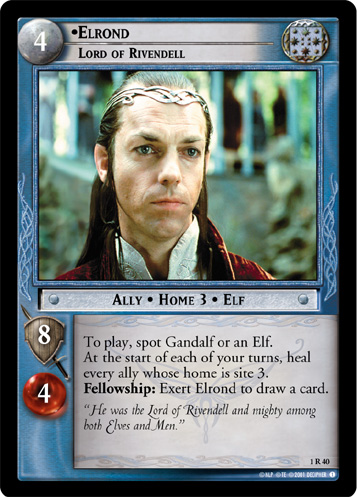 After you’re done playing things, you are forced to move to the next site. Sites have a default twilight number (in the upper right corner), which they add to the pool, and each companion in your fellowship also adds 1 twilight by virtue of existing. This acts as a balancing mechanism against having a really huge fellowship, and, it being a Decipher game, there were also a bunch of hoser cards designed to hurt large Fellowship strategies. The Shadow player (your opponent) now has a chance to use all of the twilight you generated to play minions , conditions and equipment. Minions have a “roaming” restriction that gives them +2 cost if they’re played to a site before their home site (the number in the bottom left), and the other cards generally have culture restrictions, where they require "spotting" an appropriate minion type, or only being allowed to be equipped by an appropriate minion. 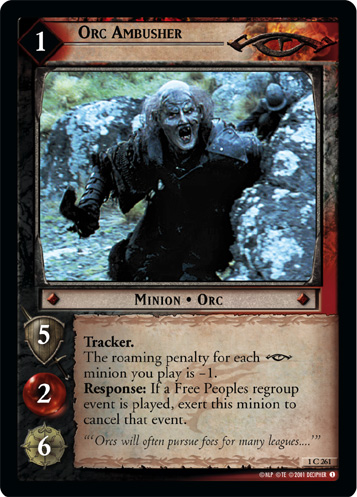 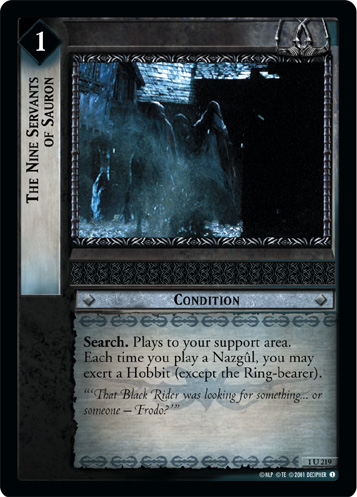 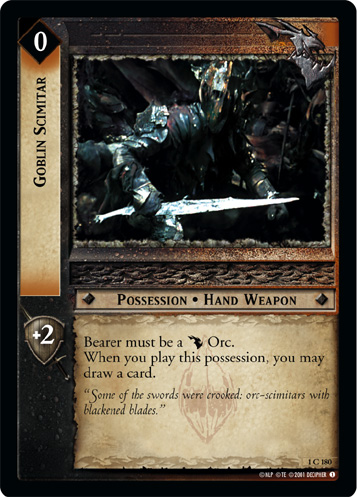 After the shadow player is done playing cards, both players’ archers fire, generating 1 wound that must be assigned for each character with the Archery tag. Next comes assignment, in which the Fellowship can assign any characters they control to minions. After the Fellowship is done assigning, any unassigned minions can be assigned by the shadow player as they choose. The Fellowship player then chooses the order in which the skirmishes resolve. In each skirmish, the strength totals of the two sides are compared, with the losing side taking a wound for each participating character (plus an additional wound for each damage +1 modifier on the winning side). If one side is at least twice as strong as the other side, the losing side is overwhelmed, causing all the losing characters to immediately die (this was an excellent way to kill a ringbearer, as otherwise they'd "put on the ring" and take burdens instead of wounds). After the main skirmish phase, there’s a second skirmish phase for Fierce minions, which is resolved in the same way. The shadow player then draws back up to 8 cards, and presents the Fellowship player with the most consequential decision of the game, whether or not to attempt a second move. If the fellowship moves again, they generate twilight again, all of the undefeated minions stick around for another round of attacks, AND the shadow player gets to play even more threats. However, double-moving is also key to actually winning the game, since the player who makes it to Site 9 first wins. Most well-built fellowships tended to try to double move on the first turn 1->2->3, since starting the next turn at a sanctuary gives a chance to heal before the next leg. Double-moving 3->4->5 could be quite risky, as you’re starting on a non-sanctuary, and the higher the site number, the more twilight the sites generated and the bigger the minions that would no-longer be “roaming”, but could be a good way to get a big advantage. Another consideration was the shadow player’s hand. Since the game was built around a hand-refill mechanic, a shadow player who played few cards in in the 1st move might have few shadow cards to attack during the second move. Normally players are restricted to only 2 moves, but some cards increase the move limit, allowing you to take advantage of a stumbling opponent and get really far ahead. When the fellowship player stops, they refill their hand to 8 cards, and play passes to the shadow player, who becomes the fellowship player. My experience with the game I played the game off and on during the Fellowship and Two Towers Blocks and a very small amount of play during the Return of the King Block. I was not very good, and mostly played with my family, though I did play a few times at the local Nebraska game-store. I felt that this game, out of all the Decipher TCGs, was the best balanced and the most interactive. Moreover, because of the aggressive focus on the main characters from the movies, even commons were playable in many decks. The core mechanics are interesting, and, if you were as into the Peter Jackson movies as I was, it’s fun to be able to “re-live” a bunch of your favorite moments. That said, I enjoyed this game a lot less than the other LoTR card game, mostly because the game was so focused around emulating the story of the movies rather than having your own adventures in Middle Earth. Also, it felt weird to have members of the Fellowship die partway through the story (I mean, members of the fellowship that aren’t wizards or Boromir). Finally, later sets (after the release of all of the LoTR movies) had huge changes to the rules, including the addition of alternate ringbearers (like Gandalf, Boromir, and Bilbo), the complete remapping of the cultures to a smaller set, and a change to the site rules that basically had the site deck be a set of 9 cards in arbitrary order, instead of the fixed 1-9 sets of sites in the movie blocks were enough to completely lose my interest in the game.
|
|
|
|
CitizenKeen posted:
Is this from an LGS? 50$ for a starter and the privilege of getting to play in an event for a day? This has gotta be a joke.
|
|
|
|
Railing Kill posted:Generally very good deck advice I feel compelled to note that while this advice is a great way to make decks, there are a couple of other approaches. Goodstuff piles In many games/formats there will be cards that are just better than other cards on rate, because they match up well against common meta cards, or what have you. A solid approach to deckbuilding (that I hate, but is pretty good) is to play whatever deck let's you maximize the number of these cards you can play. Then add removal and card advantage (draw/discard/2-for-1s) to taste. Archtype decks Another approach is to focus on filling a broad deck archetype, commonly control or aggro. Control Decks A control deck looks to focus on answering your opponents threats, typically in the most efficient way (card wise) possible, drawing cards, and only winning the game when you have the game locked down. Control decks want to have lots of resources (in general) since they tend to have cards to make use of the resources. Aggro decks An aggro deck is looking to win the game against a goldfish as fast as possible, and play enough disruption to make you opponent unable to stop you. Aggro decks tend to play fewer than normal resources, and lots of cheap threats, counting on their ability to play through all their cards before you can play through yours (and also having more cards that "do things" since they have fewer resource cards) Synergy decks can be more fun and interesting, but decks where each piece is powerful on its own, like goodstuff decks, or is largely interchangeable, like in archtype decks, tend to do well when there's a lot of 1-for-1 interaction, because they tend to be robust (e.g. in Magic, healthy formats tend not to have too many synergy decks). Not sure how things work/will work in other games, but it's a useful set of lenses to apply, I think.
|
|
|
|
CapnAndy posted:Yeah, it really does. I'll write one up tomorrow to kill time at work if nobody else wants it. Lorcana: Disney's Most Advanced Wallet Removal Technology
|
|
|
|

|
| # ¿ May 18, 2024 10:03 |
|
CitizenKeen posted:What the hell is Bof2? Bofa DEEZ GAMES
|
|
|







